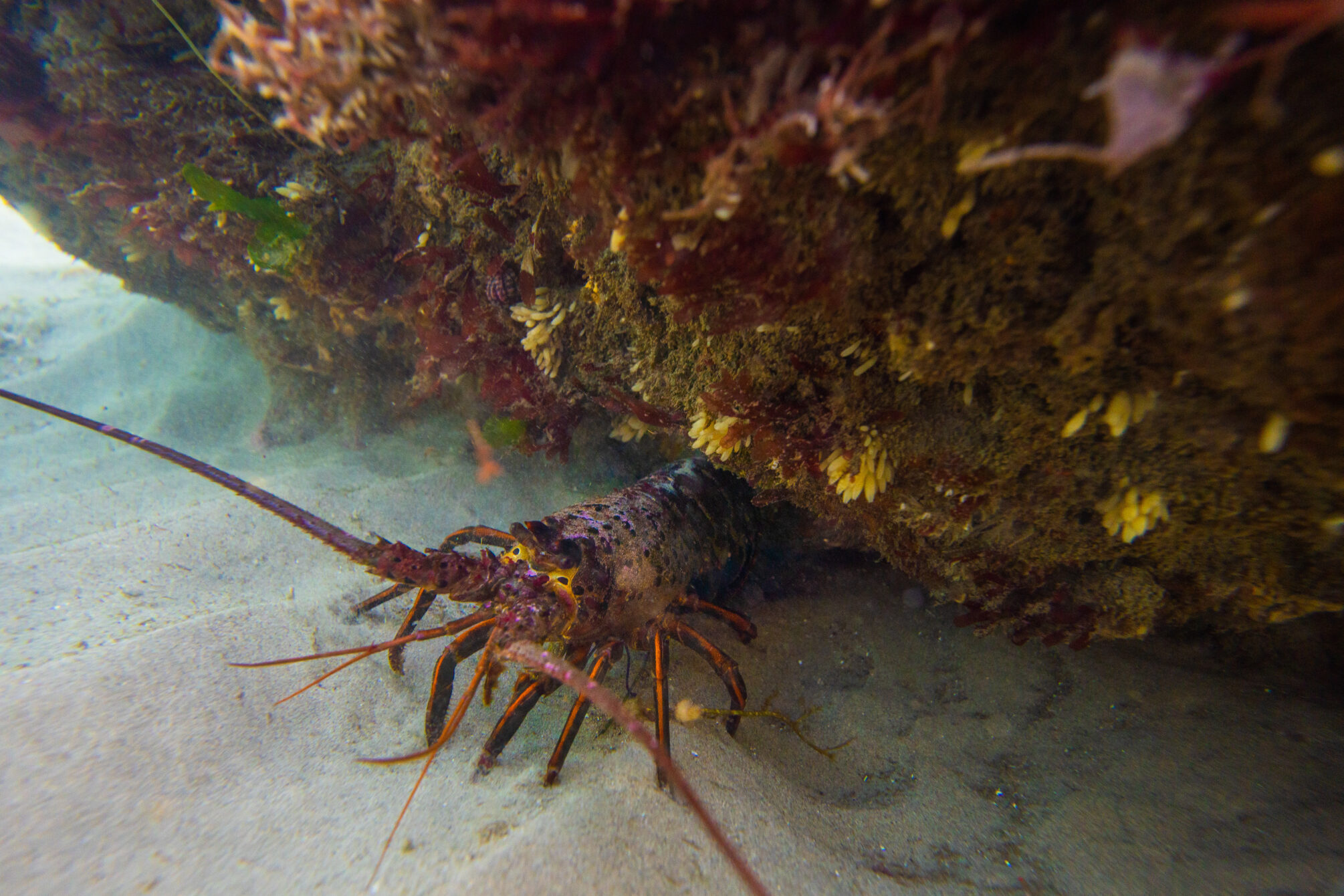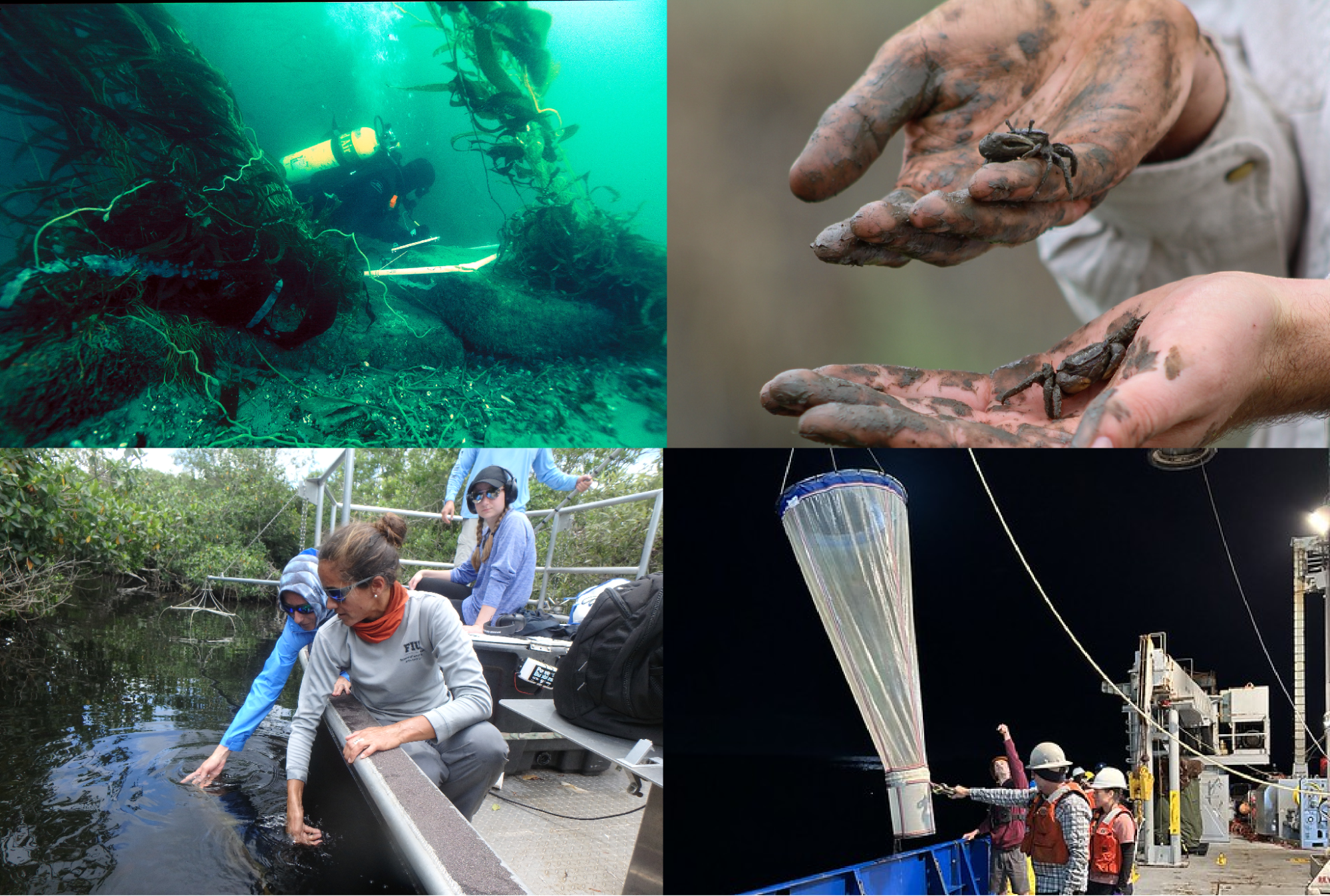Marine LTER sites come together to synthesize how consumer-mediated nutrient dynamics are changing throughout time and in response to disturbances
Written By Dante Capone, a PhD Candidate at Scripps Institution of Oceanography University of California, San Diego and the California Current Ecosystems LTER
Beyond consumption: understudied contributions of consumers to ecosystem functioning
Prairie grass is grazed by the rabbit; the rabbit is then hunted by the fox. As young ecology students, we learn that energy flows one way, from low levels on the food chain to high ones, in ecosystems. However, there is another vital pathway for energy to move in the reverse direction. What goes in as food or prey comes out as excrement, which fertilizes the base of the food chain. In the prairie, the excreted nutrients feed back into the soil, allowing for grass to grow and begin the cycle again.
These processes have been termed consumer-mediated nutrient dynamics or CND. CND is especially important in habitats like coral reefs, where low nutrient concentrations and limited sediment storage make animals the key source of nutrient flow. Even in environments that receive high nutrient inputs, CND may still be important for sustaining the ecosystem across seasons or disturbances. For example, the California Current receives an ample supply of nutrients from upwelling of deep, rich water. But when marine heatwaves hit, the cold upwelling water gets blocked by the warm surface water; algae may depend more on recycled nutrients from fish and zooplankton during these events.

Credit: Gabriel De La Rosa, CC BY-SA 4.0.
Foundational time series research in Santa Barbara kelp forests found that seemingly small invertebrates can shoulder large responsibility in contributing to CND. More than 60% of the ammonium (the form of nitrogen provided through CND) can be supplied through a single sea star species which subsidizes kelp forests through lower nutrient periods. However, when the sea stars were struck with a devastating wasting disease, a new invertebrate player, the spiny lobster, took the mantle of ‘key excretor’ and sourced a majority of the ammonium. It remains unclear whether these types of substitutions or niches hold across different ecosystems and how diversity impacts CND in the face of multiple stressors.
Striving for Synthesis: Struggles and Strengths
To understand how CND changes over time and responds to disturbances in marine ecosystems, I joined in a coordinated synthesis effort across 8 LTER sites as well as the Partnership for Interdisciplinary Studies of Coastal Oceans monitoring program. I served as a representative and contributor from the California Current Ecosystems LTER alongside two fellow PhD students in my lab. The process of uniting scientists from various sites to harmonize data and tackle big ecological questions is challenging given the diverse methods and interests of the researchers involved. Though often neglected in the scientific process, this collaborative step of cross-comparing different ecosystems and forging interdisciplinary connections is essential as we collectively face global climate change. The LTER Network provides the perfect ingredients for synthesis studies: diverse, data-rich sites; overarching scientific goals; and team-oriented scientists.

The abundance and importance of certain consumers, the established historical sampling and the questions that captivate researchers all dictate what data are ultimately collected at an LTER site. Our effort spanned LTER sites. The Florida Coastal Everglades LTER conducts electrofishing surveys from small river boats at the marine and freshwater interface. At the coral reefs of the Moorea Coral Reefs LTER and kelp forests of the Santa Barbara Coastal LTER, researchers transect lines on scuba. Open ocean sites at California Current Ecosystem LTER and Northern Gulf of Alaska LTER are studied via net tows off large research vessels. Other coastal sites like Plum Island Ecosystems, Virginia Coastal Reserve, and Georgia Coastal Ecosystems LTERs traverse the seagrass and marshlands associated with the dynamic intertidal zone to sample resident fishes and invertebrates.
At my site in the California Current, we seek to understand how the physics and chemistry of the ocean influence biology. We study plankton, which are easier to collect off large research vessels, highly abundant in the ecosystem, and closely track changes in the physical and chemical environment. Experiencing the full cycle of pulling a plankton net from a research vessel out in the Pacific Ocean, processing the sample back in the laboratory on land, and seeing those organisms appear as data in a multi-ecosystem spreadsheet, has given me a profound respect for the immense undertaking of synthesis science at the multi-site scale. Underlying each entry into a spreadsheet are dozens of hours of curiosity, labor, and care.

Credit: Dante Capone, CC BY-SA 4.0.
Concocting a Successful Synthesis
To facilitate focused work, our team assembled for 2 weeklong workshops at the National Center for Ecological Analysis and Synthesis (NCEAS) in downtown Santa Barbara. Synthesis workshop days were filled with deep-focus. We divided labor between a data team and a conceptualization or writing team, and our work was supported from the NCEAS staff of expert data scientists.
The first morning in Santa Barbara our team was off to a quick, hard bonding as we piled into the local members’ cars to escape an unprecedented Southern California downpour. Squeezing soaking wet into a packed backseat amongst both PIs and other graduate students immediately set the tone for what would be a welcoming and level stage for scientific contribution.
Mack White, a graduate student from the Florida Coastal Everglades site, was the leader of the synthesis team. Though we had all met previously on Zoom, Mack’s blend of laid-back nature, focus, and dedication mitigated any tension and set everyone at ease. Observing the balanced exchange of Mack’s determination to keep our lot of diverse researchers on track but willingness to accept all forms of feedback and constructive criticism, and the unwavering positivity and encouragement of the principal investigators (PIs) made me recognize my own ability to contribute.
With no veteran scientists from my California Current site, I quickly realized that my lab mates and I were the experts in the room on our data and our ecosystem. Freed from the usual power dynamic that is typical of a graduate student who is still learning, I gained confidence that my contribution to this team was meaningful. Furthermore, our site’s focus on oceanic plankton was unique compared with many more coastal and fish-centric sites. These differences facilitated both educational discussion and the friendly banter of the invertebrate-vertebrate rivalry.
After Mack’s morning debriefs, I would spend each day staring intently into my R coding console or sifting through scientific literature in the tiled mission-style conference room looking out towards the Santa Ynez Mountains. Angel Chen, Li Kui and Nick Lyon, resident data scientists of the NCEAS staff, bounced about the meeting room attending to our stream of struggles in harmonizing our data, always serving up a clean solution without complaint. The atmosphere of focus was only broken by the necessary coffee trips to and from the mural-decorated NCEAS breakroom or to explore the walkable downtown for lunch.
Downstairs, the ‘conceptualization’ team, composed mainly of big picture thinkers like the PIs, juxtaposed our silent coding with animated discussion and sketched out potential frameworks and figures for our study on the whiteboard. At the end of each day, we would reconvene; the conceptualization team shared their structured questions and ideas for our study, which provided the data team with tangible analytical tasks to tackle the next day. In turn, graphs presented by the data team generated new perspectives for the conceptualization team and served as food-for thought for the next days’ writing. This symbiotic workflow, guided by Mack’s reminder of our weekly goals and nurtured with our growing friendships was key to successful synthesis.
Our second meeting, though smaller in attendance, flowed similarly. We saw the fruits of the first meeting by getting the chance to dig into the freshly published harmonized dataset generated in the previous meeting, began teasing out our first study and sowing the seeds for a second. The first study from the synthesis effort focuses on characterizing how fluctuations in nutrient excretion differ across and within sites and understanding what drives its stability through time.

Credit: Used with permission from the Consumer Nutrient Dynamics working group.
The Fruits of Synthesis
Preliminary findings reveal that the stability of nutrient supply by consumers is driven in part by diversity—both in species richness and trophic diversity. Furthermore, the degree to which animals were synchronized in excretion also proved important. The more asynchronous different consumers were in the timing of their nutrient supply, the more stable the supply was over time. Intuitively this makes sense, as when disturbances disrupt an ecosystem, many species face collective negative impacts.
Initial exploration into the impacts of disturbance across ecosystems shows that not all disturbances we identified impact CND. Some sites like the Florida Coastal Everglades experience intense extreme events such as cold snaps and droughts where many fish species are simultaneously impacted. Other sites like Moorea Coral Reef faced biological rather than physical disturbance with the outbreak of the destructive Crown-of-thorns starfish. We have several sites on the US West Coast that were all impacted by the same massive disturbance: the 2014-2015 marine heatwave. While certain organisms like kelp were negatively impacted by the heatwave, other animals like gelatinous zooplankton flourished. Having a team of researchers who have played a part in collecting the harmonized data has been vital to the interpretation of unexpected results.
The dataset and processes through which these disparate data sources were harmonized will outlast our working group, living on as a valuable contribution to LTER science. The dataset offers a wealth of novel information to explore on trends in CND across sites, taxa and other environmental characteristics and could even be combined with other LTER or synthesis products.
First Impressions, Final Thoughts
After long days in the meeting rooms, we used the evenings to explore downtown Santa Barbara and provide our brains with a brief respite from the demands of synthesis. We enjoyed multiple miles of walking up and down State Street to grab beverages in the Funk Zone. Mack, myself and others found great joy in riding the local e-bikes not just to and from NCEAS, but even taking them for a late-night ride along the Santa Barbara bluffs. Of course, no trip to California as marine scientists would be complete without jumping into the ocean environment that we were studying. These extracurricular experiences and opportunities to learn more about our fellow synthesis researchers as people were pivotal for me in solidifying a positive association with this first taste of synthesis.
Synthesis work provides insight into the tools, data, and skills other LTER scientists leverage. It allows us to zoom out from the usual niche of our specific site and research to connect and attempt to answer larger ecological questions. Finally, it forges cross-site connections and friendships, opening the door for future exchanges in research, travel, and even fieldwork.

Credit: LTER Network Office, CC BY-SA 4.0.










